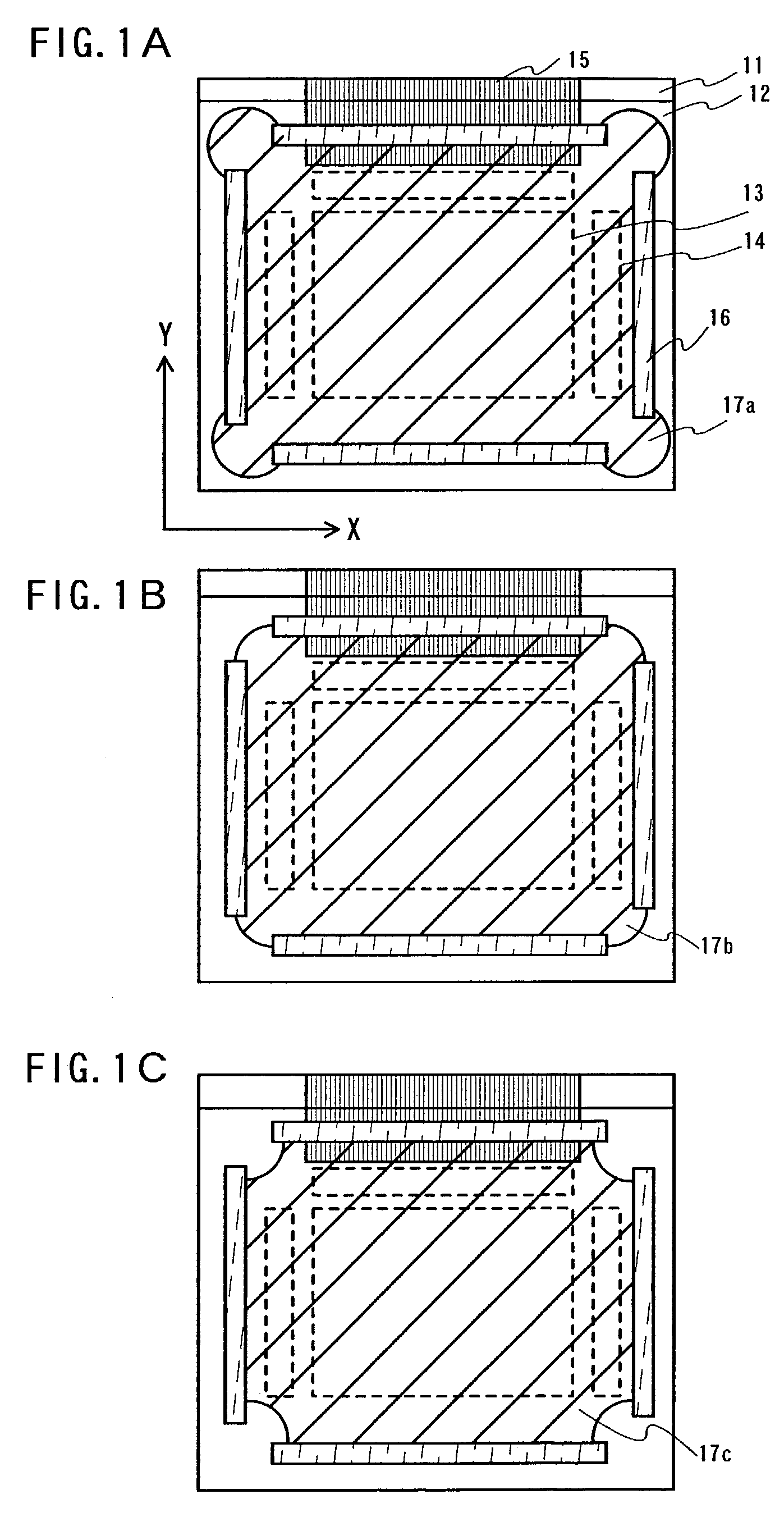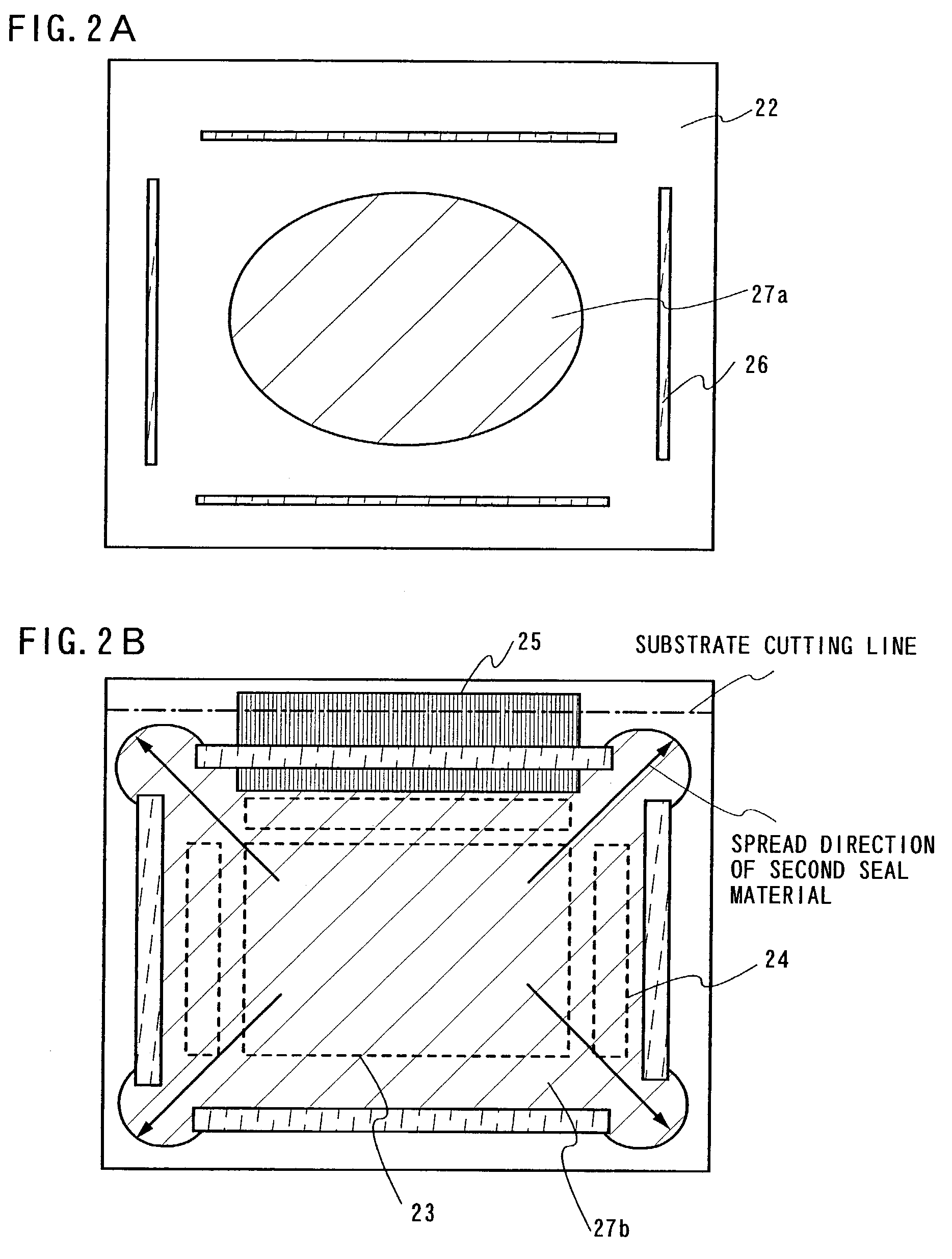Light emitting device having pixel portion surrounded by first sealing material and covered with second sealing material
- Summary
- Abstract
- Description
- Claims
- Application Information
AI Technical Summary
Benefits of technology
Problems solved by technology
Method used
Image
Examples
embodiment mode 1
[0101]FIG. 1A is a top view of an active matrix light emitting device that implements the present invention.
[0102]In FIG. 1A, reference numeral 11 denotes a first substrate, reference numeral 12 denotes a second substrate, reference numeral 13 denotes a pixel portion, reference numeral 14 denotes a driver circuit portion, reference numeral 15 denotes a terminal portion, reference numeral 16 denotes first sealing materials, and reference numeral 17a denotes a second sealing material.
[0103]There are no specific limitations placed on the material used for the first substrate 11. It is preferable, however, to use substrates having identical thermal expansion coefficients for the first substrate 11 and the second substrate 12 because the two substrates are bonded together. A substrate having transparency, for example, a glass substrate, a quartz substrate, or a plastic substrate, is used for the first substrate 11 material if a bottom surface emission light emitting device is manufacture...
embodiment mode 2
[0119]A portion of a cross sectional structure of a pixel portion of the present invention is shown here in FIG. 3A.
[0120]In FIG. 3A, reference numeral 300 denotes a first substrate, reference numerals 301a and 301b denote insulating layers, reference numeral 302 denotes a TFT, reference numeral 308 denotes a first electrode, and reference numeral 309 denotes an insulator. Reference numeral 310 denotes an EL layer, reference numeral 311 denotes a second electrode, reference numeral 312 denotes a transparent protective layer, reference numeral 313 denotes a second sealing material, and reference numeral 314 denotes a second substrate.
[0121]The TFT 302 (p-channel TFT) formed on the first substrate 300 is an element for controlling current flowing in the light emitting EL layer 310, and reference numeral 304 denotes a drain region (or a source region) thereof. Further, reference numeral 306 denotes a drain electrode (or a source electrode) that connects a first electrode and the drain ...
embodiment mode 3
[0135]A case of forming a plurality of pixel portions on one substrate, that is, an example of multiple patterns, is shown in FIGS. 4A to 4E.
[0136]An example of forming four panels using one substrate is shown here.
[0137]First sealing materials 32 are formed first in a predetermined location on a second substrate 31 by using a dispenser apparatus under an inert gas atmosphere. (See FIG. 4A.) A material that contains a filler (diameter 6 μm to 24 μm) and having a viscosity of 370 Pa·s is used as a translucent sealing material for the first sealing materials 32. Further, data that shows the relationship between the size of the filler contained in the sealing material and the adhesive strength is shown in FIG. 9. Furthermore, the first sealing material 32 can be formed by print process because it has a simple sealing pattern. Next, a transparent second sealing material 33 is dripped on the region surrounded by the first sealing materials 32 (with openings in four corners) (see FIG. 4B)...
PUM
 Login to View More
Login to View More Abstract
Description
Claims
Application Information
 Login to View More
Login to View More - R&D
- Intellectual Property
- Life Sciences
- Materials
- Tech Scout
- Unparalleled Data Quality
- Higher Quality Content
- 60% Fewer Hallucinations
Browse by: Latest US Patents, China's latest patents, Technical Efficacy Thesaurus, Application Domain, Technology Topic, Popular Technical Reports.
© 2025 PatSnap. All rights reserved.Legal|Privacy policy|Modern Slavery Act Transparency Statement|Sitemap|About US| Contact US: help@patsnap.com



